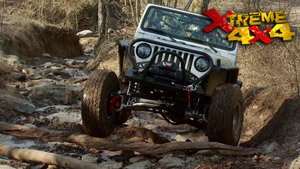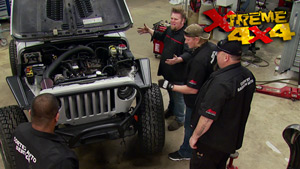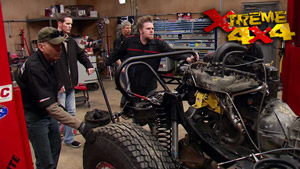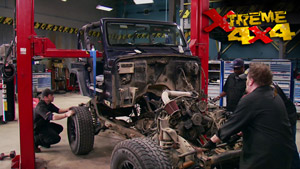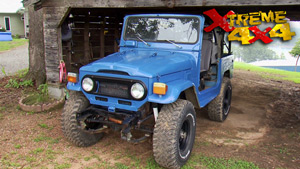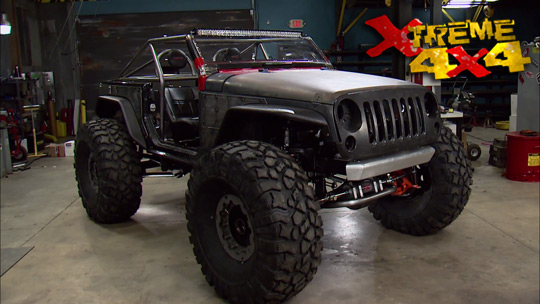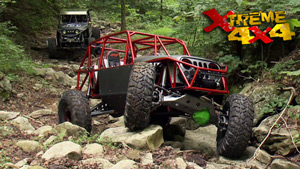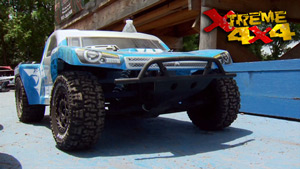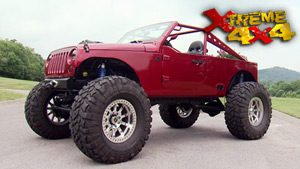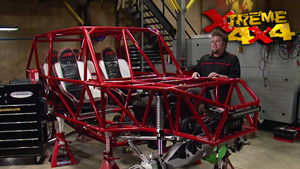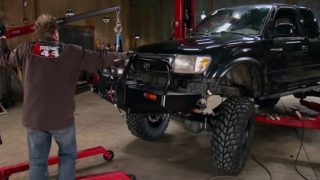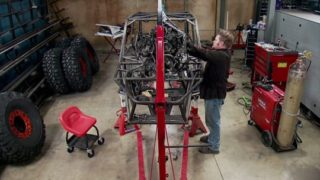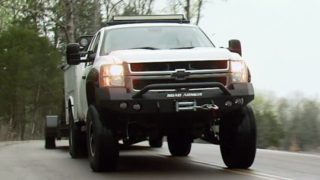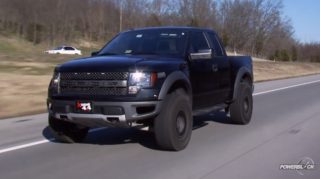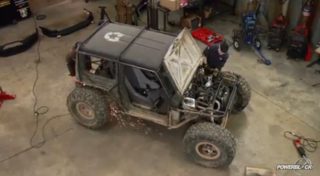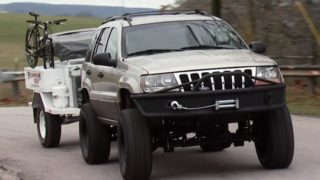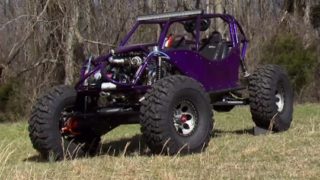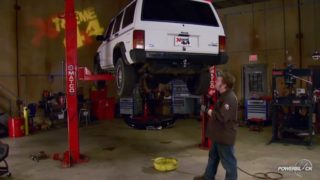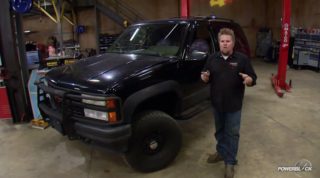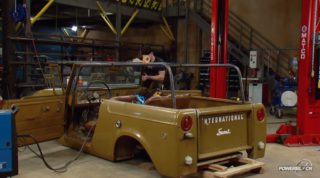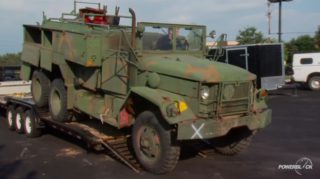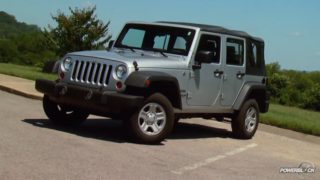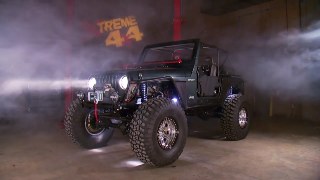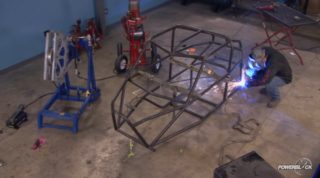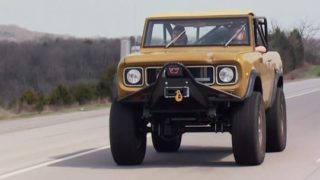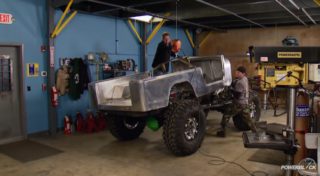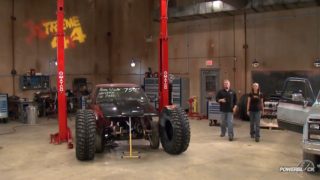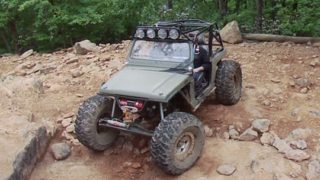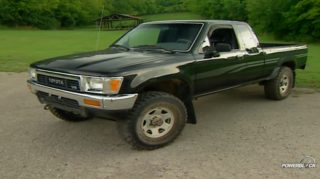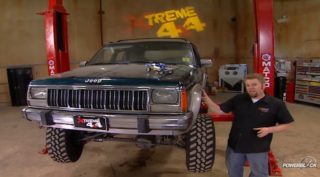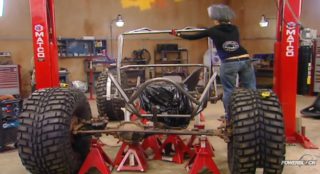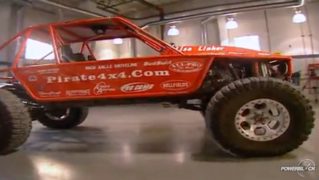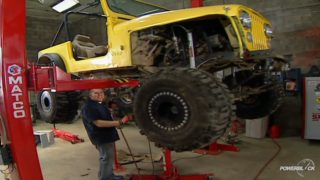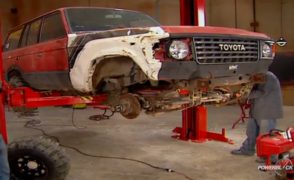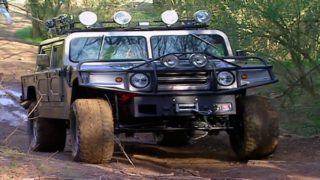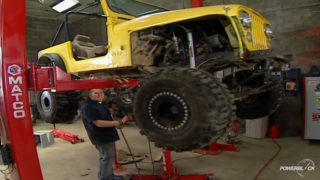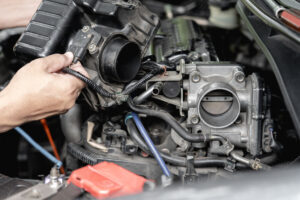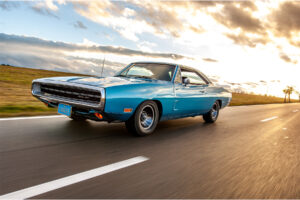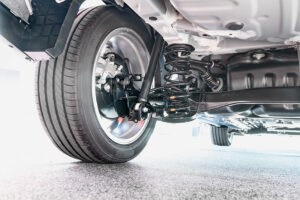Xtreme 4x4 Builds
Want more content like this?
Join the PowerNation Email NewsletterParts Used In This Episode
Bully Dog Technologies, LLC
The all new Rapid Flow exhaust kits from Bully Dog Technologies incorporates the high flow 6'' radius design with the anti-corrosion protection of aluminized steel. These kits are available for Dodge, Ford, and GM full sized diesel pickups. All kits also come with stainless steel tips to complete your exhaust., The RFI is an advanced airflow induction system built to increase the engine's ability to breathe; thus increasing horsepower, torque and fuel efficiency, while decreasing exhaust gas tem
Kelderman Mfg.
Adding a Kelderman Air Ride Conversion Kit to your existing suspension will provide a level of comfort you thought was impossible. This is particularly true when the truck is not loaded. By loosening the rear spring shackle from the frame and attaching it to the Air Ride you have effectively provided yourself with a two-stage suspension system that smoothes the road. The Kelderman Air Ride is not to be confused with just adding an Air Bag between the axle and the frame. This type of system is me
Video Transcript
Every now and then at Xtreme 4x4, we like to clean up the shop, put away the tools and cover a topic for the entire day in extreme detail. Now, we've done it with transfer cases and we've done it with axles. Most recently, we talked about different types of suspensions. Now, today we're going to cover something that we do every time we go four wheeling, even if you're not a hardcore wheeler, I'm sure you've done it once or twice and that is towing. It's a very
important topic because there's lots of guys out there hauling junk around and it's not safe
and we're going to start by talking about different hitch classifications. Now, there's a couple of different things we talk about with hitches. One is gross trailer weight and that is the weight of the trailer as well as everything you put on it. And the other one is tongue weight. That's the weight of the front of the trailer resting down on the ball and we'll start with the smallest hitch. There is, this is a class one trailer hit,
it can handle a 2000 pound gross towing weight as well as a 200 pound gross tongue weight. Now, this is obviously an incredibly light duty hitch. If you have a step bumper on the back of your pickup truck, it's honestly probably a class one hitch. If you're just towing a lawn tractor out to cut the grass, that's what all that's good for. If you want to haul something heavier, you got to step up to probably a receiver type hitch. Now, this is a class two hitch. It can handle
3500 pounds of gross towing weight and 350 pounds of gross tongue weight. They're easy to identify because they have these small inch or inch and a half receivers. Now, this is good for maybe a mid size SUV hauling a boat out for a weekend. Efficient. Certainly no good for a car on a car trailer and a rig on a trailer to go out, wheeling you max this hitch out right away. You need to step up to something bigger.
Probably the most common type of hitch you're gonna find is a class three receiver hitch. You'll even find these matters underneath some pickup trucks coming straight from the factory. Now, it's a pretty good hitch. It can handle 5000 pounds of gross trailer weight and 500 pounds of gross tongue weight. Now, that sounds like a lot, but honestly, if you're into wheeling, it's not enough when you figure out the size of a full size crawler, you're always gonna be knocking on the door of just under 5000
pounds, throw a trailer underneath that and you are well above the maximum load of a class three hitch. So if you're into four wheel and towing your dunk to the trail, this hitch
not good enough.
So we've established that if you got any type of healthy size rig, like our scout, you're going to need a class four hitch. Now, the hitch all by itself can handle 7500 pounds of gross towing weight and 750 pounds off the to
I should be able to handle any buggy out there on a flatbed car hauler. If you do need to carry more weight, you can upgrade this hitch with one of these weight distribution hitches. Now it keys off the receiver and these two torsion arms travel down the a frame of the trailer. What it does is it shares the load between the trailer and the entire vehicle, not just the tongue of the trailer hitch. So what you've done is if your load is driving down the road like this with a weight
hitch, it will even it out even if you aren't maxing out a class four hitch. If you're doing a long hauls, a weight distribution hitch like this will make towing a lot more enjoyable. A weight distribution hitch upgrades the class 4 to 10,000 pounds total load and 1000 pounds off the tongue. Now, that's pretty much where you're gonna want to stop on a bumper pole. If you're pulling more than 10,000 pounds, you want to get off the bumper and into the bed.
There are two reasons to upgrade from a bumper pull hitch up to a goose neck. Now, the first is going to be weight of the trailer and the second is length. If you're hauling anything larger than a single auto transport, it's a good idea to get up to a goose neck just because of the shared load of the total trailer. Now, gooseneck ball hitches work better because they distribute the load right over the truck's rear axle. It's like the load is in the bed of the truck. Now, how much can you tow? Well, honestly, it depends on your tow rig and its rating, but the hitch itself can handle 30,000 pounds of gross towing weight and 7500 pounds of pin weight up here at the top. Now, that means that if you got two or three rigs that you want to get to the trail, you're gonna want a gooseneck hitch in your truck.
Now, just like a trailer hitch is rated to weight the ball that connects the trailer to the hitch is also rated for weight. A small ball like this inch and 78 ball maxes out at about 2000 pounds. Now, the next size up being the two inch ball can handle a 7500 pound load and the largest ball, the two and five
16 can handle 10,000 pounds. So this is the size of choice for hauling a car trailer or towing your rig to the trail. Now, one nice thing to get is one of these triple ball receiver setups. So if you're like me, you got a bunch of trailers laying around the yard all for different applications, you can simply swap it around in the receiver depending on what you plan to haul.
Now, before you hook your trailer up to your truck, you need to make sure that you have the right electrical connection for the two of them to work together. There was a point in time when the only electric connection you could get was one of these flat four trailer light connectors and it had four wires that were bared on the ends that you had to cut into your existing harness to make work. The aftermarkets made it a lot easier for us. Now, they have these little plug and play adapters. This just goes in line in a connection in your vehicle's harness and you instantly have trailer lights. That's the one downfall to the flat four connector. That's all it is. It's just a trailer light connector. It just controls turn signals, brake lights and tail lights. Now, this is not enough outputs for a seriously loaded trailer for a heavy duty trailer. You need one of these round flat seven pin setups Now, these have an additional outputs put in them to control things like trailer brakes as well as axiliary lights. If you have two trailers and you're worried that you won't be able to hook up to the flat four pin as well. You can get one of these little adapters that will adapt the round seven pin down to the flat four pin when you're hauling light loads. Now, trailer brakes are a must when you're hauling a crawler to the trail and most new trucks have a brake control module built right into the dash. But if you've got an older tow rig, you can pick up one of these and mount it in yourself. You can
adjust how hard the brakes are applied depending on your load and you can even control the brakes with this little slide feature right here. Now, trailer brakes will help make towing a lot easier because the whole load will slow down together. You won't have the load trying to push your truck down a hill. Even if you've just got a half ton truck, 16 ft car trailer with a light load on it. You're gonna wanna install a brake control module and get brakes on your trailer
today. On extreme, we're taking a look at towing everything you need to know from hitch selection all the way down to adjustments you need to make to your truck to make it easier and more important how to do it safely. Now, right now, we're going to look at the one area that probably gets neglected the most. And that is the trailer. Think about this. We probably put some of our life savings on the back of one of these things and drag them down the highway at 75 miles an hour. And the trailer itself very rarely gets maintained. So we're gonna go through some maintenance tips that you should do at least once a year.
The most important item that you need to check are your tires and start with the tread and make sure there's even wear across the entire contact patch. If the tire is wearing on the inside or the outside only, it probably means that you've got a bent trailer axle. You gotta remember that's caused by overloading the trailer that can happen pretty easily because a lot of people forget to include both the weight of they put on the trailer and the trailer itself and they'll max out those axles. So keep that in mind. Now, you'll wanna go ahead and also remember to get actual trailer tires. If your tires are wearing out, don't just pop down to the local used tire store and get some tires that are the same size, get trailer specific tires. They are designed to handle the load and weight of your trailer and what you put on it
with the wheels and tires off. This is an ideal time to service your wheel bearings. And what you wanna do is pull them off the spindle check to see if there's any chunky in them. If they are chunky when you spin them, they're obviously garbage. If not, you just have to clean them up and pack them. Now, some very high quality trailers will have a stub axle with a built in Zerk fitting right at the end. If it has this, it has a grease passage that goes back and greases the rear bearing as well as the
aren't bearing. So you don't have to tear it down to grease them. Ours doesn't have that. So the only way to service these is to take it all apart, but it's a good idea to take it apart anyway, because it gives you a chance to look at your brakes. As you can see, this trailer has trailer brakes on both axles and our shoes are in very good shape. It's a little bit of dust build up. So we'll blow that out and give the shoes a light scuff with some sandpaper. Now, trailer brakes are kind of cool how they work. There's just a little electrical connection and a magnet right here. The bottom of the drum as the drum turns around. When you activate the trailer brakes, the magnet will grab onto the drum and activate the brake shoes just like on the rear of a pickup truck, except it's not done with hydraulic fluid. It's done with electricity. Now, when you assemble this all back together. You do want to adjust your trailer brakes so that when you spin the drum, you have a very light drag on the shoes and then put your bearings on. So there's just a little bit of end play and then everything will be good for your next halling trip.
Now, it goes without saying every time that you put a load on your trailer, you're gonna want to perform a basic light check. Make sure your brake lights work as well as all your turn signals. But it's also a good idea once a year to give all your lights a good visual inspection problems like what we see right here will pop up. This lens is broken just along the top edge. It might not seem like a big deal. But when you're driving down the highway, you could lose the rest of this lens or worse water can now get into this light and cause the bulb to fail and we'll lose this
corner marker. That means no brakes, no signals, no fun when you're hauling a trailer. Also a good idea to check all your wiring go over the whole trailer, make sure nothing's chafing against any metal. If it's broken through the insulation, cut the brake out, put in a new piece of wire and electrical tape, it all back together. You also want to give your trailer a complete visual inspection front to back, check things like your steak pockets. Make sure the welds are good. Check your tie downs, make sure they haven't loosened up. Make sure your ramps store away safely and securely and just go over the entire trailer and look for any problem welds and any structural member, check your tow chains and your breakaway box as well as your coupler. If there is anything that's questionable, now's the time to replace it. Heck, you can even go ahead, sand it down. Give it a coat of paint and help it last a lifetime. You gotta think of a trailer as more than just an investment of the cost of the trailer itself. Every time you put your rig on this thing, you're trusting your rig's life to what's underneath it. This trailer, if it's well maintained, your junk will get to the trail.
Now, if you've bought a truck like this, you're probably planning some serious hauling. And I'm not just talking about taking your rig down to the off road park for the weekend.
I mean, taking a serious load of rigs probably across the country for some hardcore off roading. Now, this truck would work pretty good right out of the box, but just like we modify our trail rigs to handle some serious terrain. We can modify our tow rigs to handle some serious loads.
The first thing we're going to talk about is load leveling. When manufacturers design a pickup truck, they have to dance a fine line. They want the leaf springs in the back to be strong enough to carry a serious load, but they also want them to be soft enough. So when the back of the truck is empty, you still have a good ride. And what that means is occasionally, when you load up the truck with a lot of weight, like in the thousands of pounds, the back end of the
truck will squat down. This can become a danger issue because if you put too much weight in the back end of the truck, the front wheels can get light and it can affect your steering control. Now, the best way to solve this is to add a load leveling device in the back. And the most popular is a set of air bags on top of the leaf springs and up to the frame that you inflate with air when you've got that heavy load. Now we're going to install a set of airbags, but they're a little bit different.
This load leveling setup is from Kelderman manufacturing. Now, instead of putting a leaf spring between the axle and the frame, it puts it in a different location. It replaces the truck's stock hitch and then adds the swing arm assembly that replaces the swing shackle for the leaf spring. Now, that means that we still get all the natural leaf spring movement when we're driving the truck. But when we want to carry an extra load, we inflate this airbag between the frame and this plate behind the swing shackle to adjust the vehicle's ride height. But at the same time, we'll still get a nice smooth ride because we haven't stiffened up the leaf spring.
Ok.
One of the great things about choosing a diesel truck for your tow rig is you can add power ADDers to handle that extra load. Now, one thing you do want to keep in check when you start adding power is to keep an eye on your EGTS or your exhaust gas temperatures. The best way to handle that is to upgrade your exhaust. Now, we're going to install this full bully dog five inch DPF back exhaust kit. Now it's ceramic coated and the ceramic coating is on there for a couple of different reasons and not only will it keep the pipe looking brand new for its entire life, but more importantly, it keeps the heat from the flowing exhaust from getting the actual pipe too hot. If the pipe starts to heat up, it can actually deform slightly cause turbulence inside that exhaust pipe. That turbulence is about the same amount as a stock muffler. It's going to rob you of power.
Yes,
no matter how modern an engine, the basic principle of adding more air means more power.
The bully dog rapid flow induction cold air intake picks up cool air from the inner fender and then passes it through a high flow, high quality reusable filter element. The injection molded box is designed to protect the air from under hood temperature. Now that we have more air in the engine, we can set
a
so we're gonna be adding a little bit of power to our engine with the bully dog GT tuner set up. Now, this will give us a little bit more power and a little bit more torque. Nothing crazy just enough to help us out with the towing. But what's more important is it has a complete gauge readout on the left hand side, you can see in this demo mode that it's showing us everything we need to know. Plus it has an integrated driving coach,
help us save up to 30 percent more fuel just by changing how you drive your truck. Now, one thing you have to watch out for on the modern diesel is you can actually have diesel particulate filter problems when you start doing these modifications. The bully dog kit is designed to work all together so you have no problems with your DPF.
We're going to install our
GT tuner on the bully dog dash pod.
Keep it within easy reach. Now, one of the best features of the GT tuner is the ability for you to choose your own de
fueling points. This allows you to set your upper temperature limit for all your vital engine fluids, your transmission temperature, your egts and even your boost, keeping your truck in check when you're building some serious power.
Now, this wouldn't be much of a towing show if we didn't talk about how to load your rig on your trailer and secure it safely.
You want the majority of your rigs weight right over the axle on your trailer. A little bit of it to the front to weigh down the tongue. So the trailer follows the truck really straight and true and then you're ready to strap your rig down. Now, some guys, they go all out and they'll use heavy duty chains just like a trucker. They're definitely strong, but they are somewhat cumbersome. A more popular item are axle loops and ratchet straps, but no matter which way you choose to secure your rig, how you secure it is more important.
Cross strapping uses triangulation just like in a roll cage or a suspension system to keep your rig from moving side to side and in some states
it's the law,
but we didn't upgrade this 08 Dooley to haul our Suzuki to the trail. I've got a bigger load on my mind.
We're thinking big next year on extreme. How big?
Wait,
wait,
how about 20,000 pounds big
truck this large? It's kind of a cool name like
private Pebble or
General Granite or
Corporal Stone.
Show Full Transcript
important topic because there's lots of guys out there hauling junk around and it's not safe
and we're going to start by talking about different hitch classifications. Now, there's a couple of different things we talk about with hitches. One is gross trailer weight and that is the weight of the trailer as well as everything you put on it. And the other one is tongue weight. That's the weight of the front of the trailer resting down on the ball and we'll start with the smallest hitch. There is, this is a class one trailer hit,
it can handle a 2000 pound gross towing weight as well as a 200 pound gross tongue weight. Now, this is obviously an incredibly light duty hitch. If you have a step bumper on the back of your pickup truck, it's honestly probably a class one hitch. If you're just towing a lawn tractor out to cut the grass, that's what all that's good for. If you want to haul something heavier, you got to step up to probably a receiver type hitch. Now, this is a class two hitch. It can handle
3500 pounds of gross towing weight and 350 pounds of gross tongue weight. They're easy to identify because they have these small inch or inch and a half receivers. Now, this is good for maybe a mid size SUV hauling a boat out for a weekend. Efficient. Certainly no good for a car on a car trailer and a rig on a trailer to go out, wheeling you max this hitch out right away. You need to step up to something bigger.
Probably the most common type of hitch you're gonna find is a class three receiver hitch. You'll even find these matters underneath some pickup trucks coming straight from the factory. Now, it's a pretty good hitch. It can handle 5000 pounds of gross trailer weight and 500 pounds of gross tongue weight. Now, that sounds like a lot, but honestly, if you're into wheeling, it's not enough when you figure out the size of a full size crawler, you're always gonna be knocking on the door of just under 5000
pounds, throw a trailer underneath that and you are well above the maximum load of a class three hitch. So if you're into four wheel and towing your dunk to the trail, this hitch
not good enough.
So we've established that if you got any type of healthy size rig, like our scout, you're going to need a class four hitch. Now, the hitch all by itself can handle 7500 pounds of gross towing weight and 750 pounds off the to
I should be able to handle any buggy out there on a flatbed car hauler. If you do need to carry more weight, you can upgrade this hitch with one of these weight distribution hitches. Now it keys off the receiver and these two torsion arms travel down the a frame of the trailer. What it does is it shares the load between the trailer and the entire vehicle, not just the tongue of the trailer hitch. So what you've done is if your load is driving down the road like this with a weight
hitch, it will even it out even if you aren't maxing out a class four hitch. If you're doing a long hauls, a weight distribution hitch like this will make towing a lot more enjoyable. A weight distribution hitch upgrades the class 4 to 10,000 pounds total load and 1000 pounds off the tongue. Now, that's pretty much where you're gonna want to stop on a bumper pole. If you're pulling more than 10,000 pounds, you want to get off the bumper and into the bed.
There are two reasons to upgrade from a bumper pull hitch up to a goose neck. Now, the first is going to be weight of the trailer and the second is length. If you're hauling anything larger than a single auto transport, it's a good idea to get up to a goose neck just because of the shared load of the total trailer. Now, gooseneck ball hitches work better because they distribute the load right over the truck's rear axle. It's like the load is in the bed of the truck. Now, how much can you tow? Well, honestly, it depends on your tow rig and its rating, but the hitch itself can handle 30,000 pounds of gross towing weight and 7500 pounds of pin weight up here at the top. Now, that means that if you got two or three rigs that you want to get to the trail, you're gonna want a gooseneck hitch in your truck.
Now, just like a trailer hitch is rated to weight the ball that connects the trailer to the hitch is also rated for weight. A small ball like this inch and 78 ball maxes out at about 2000 pounds. Now, the next size up being the two inch ball can handle a 7500 pound load and the largest ball, the two and five
16 can handle 10,000 pounds. So this is the size of choice for hauling a car trailer or towing your rig to the trail. Now, one nice thing to get is one of these triple ball receiver setups. So if you're like me, you got a bunch of trailers laying around the yard all for different applications, you can simply swap it around in the receiver depending on what you plan to haul.
Now, before you hook your trailer up to your truck, you need to make sure that you have the right electrical connection for the two of them to work together. There was a point in time when the only electric connection you could get was one of these flat four trailer light connectors and it had four wires that were bared on the ends that you had to cut into your existing harness to make work. The aftermarkets made it a lot easier for us. Now, they have these little plug and play adapters. This just goes in line in a connection in your vehicle's harness and you instantly have trailer lights. That's the one downfall to the flat four connector. That's all it is. It's just a trailer light connector. It just controls turn signals, brake lights and tail lights. Now, this is not enough outputs for a seriously loaded trailer for a heavy duty trailer. You need one of these round flat seven pin setups Now, these have an additional outputs put in them to control things like trailer brakes as well as axiliary lights. If you have two trailers and you're worried that you won't be able to hook up to the flat four pin as well. You can get one of these little adapters that will adapt the round seven pin down to the flat four pin when you're hauling light loads. Now, trailer brakes are a must when you're hauling a crawler to the trail and most new trucks have a brake control module built right into the dash. But if you've got an older tow rig, you can pick up one of these and mount it in yourself. You can
adjust how hard the brakes are applied depending on your load and you can even control the brakes with this little slide feature right here. Now, trailer brakes will help make towing a lot easier because the whole load will slow down together. You won't have the load trying to push your truck down a hill. Even if you've just got a half ton truck, 16 ft car trailer with a light load on it. You're gonna wanna install a brake control module and get brakes on your trailer
today. On extreme, we're taking a look at towing everything you need to know from hitch selection all the way down to adjustments you need to make to your truck to make it easier and more important how to do it safely. Now, right now, we're going to look at the one area that probably gets neglected the most. And that is the trailer. Think about this. We probably put some of our life savings on the back of one of these things and drag them down the highway at 75 miles an hour. And the trailer itself very rarely gets maintained. So we're gonna go through some maintenance tips that you should do at least once a year.
The most important item that you need to check are your tires and start with the tread and make sure there's even wear across the entire contact patch. If the tire is wearing on the inside or the outside only, it probably means that you've got a bent trailer axle. You gotta remember that's caused by overloading the trailer that can happen pretty easily because a lot of people forget to include both the weight of they put on the trailer and the trailer itself and they'll max out those axles. So keep that in mind. Now, you'll wanna go ahead and also remember to get actual trailer tires. If your tires are wearing out, don't just pop down to the local used tire store and get some tires that are the same size, get trailer specific tires. They are designed to handle the load and weight of your trailer and what you put on it
with the wheels and tires off. This is an ideal time to service your wheel bearings. And what you wanna do is pull them off the spindle check to see if there's any chunky in them. If they are chunky when you spin them, they're obviously garbage. If not, you just have to clean them up and pack them. Now, some very high quality trailers will have a stub axle with a built in Zerk fitting right at the end. If it has this, it has a grease passage that goes back and greases the rear bearing as well as the
aren't bearing. So you don't have to tear it down to grease them. Ours doesn't have that. So the only way to service these is to take it all apart, but it's a good idea to take it apart anyway, because it gives you a chance to look at your brakes. As you can see, this trailer has trailer brakes on both axles and our shoes are in very good shape. It's a little bit of dust build up. So we'll blow that out and give the shoes a light scuff with some sandpaper. Now, trailer brakes are kind of cool how they work. There's just a little electrical connection and a magnet right here. The bottom of the drum as the drum turns around. When you activate the trailer brakes, the magnet will grab onto the drum and activate the brake shoes just like on the rear of a pickup truck, except it's not done with hydraulic fluid. It's done with electricity. Now, when you assemble this all back together. You do want to adjust your trailer brakes so that when you spin the drum, you have a very light drag on the shoes and then put your bearings on. So there's just a little bit of end play and then everything will be good for your next halling trip.
Now, it goes without saying every time that you put a load on your trailer, you're gonna want to perform a basic light check. Make sure your brake lights work as well as all your turn signals. But it's also a good idea once a year to give all your lights a good visual inspection problems like what we see right here will pop up. This lens is broken just along the top edge. It might not seem like a big deal. But when you're driving down the highway, you could lose the rest of this lens or worse water can now get into this light and cause the bulb to fail and we'll lose this
corner marker. That means no brakes, no signals, no fun when you're hauling a trailer. Also a good idea to check all your wiring go over the whole trailer, make sure nothing's chafing against any metal. If it's broken through the insulation, cut the brake out, put in a new piece of wire and electrical tape, it all back together. You also want to give your trailer a complete visual inspection front to back, check things like your steak pockets. Make sure the welds are good. Check your tie downs, make sure they haven't loosened up. Make sure your ramps store away safely and securely and just go over the entire trailer and look for any problem welds and any structural member, check your tow chains and your breakaway box as well as your coupler. If there is anything that's questionable, now's the time to replace it. Heck, you can even go ahead, sand it down. Give it a coat of paint and help it last a lifetime. You gotta think of a trailer as more than just an investment of the cost of the trailer itself. Every time you put your rig on this thing, you're trusting your rig's life to what's underneath it. This trailer, if it's well maintained, your junk will get to the trail.
Now, if you've bought a truck like this, you're probably planning some serious hauling. And I'm not just talking about taking your rig down to the off road park for the weekend.
I mean, taking a serious load of rigs probably across the country for some hardcore off roading. Now, this truck would work pretty good right out of the box, but just like we modify our trail rigs to handle some serious terrain. We can modify our tow rigs to handle some serious loads.
The first thing we're going to talk about is load leveling. When manufacturers design a pickup truck, they have to dance a fine line. They want the leaf springs in the back to be strong enough to carry a serious load, but they also want them to be soft enough. So when the back of the truck is empty, you still have a good ride. And what that means is occasionally, when you load up the truck with a lot of weight, like in the thousands of pounds, the back end of the
truck will squat down. This can become a danger issue because if you put too much weight in the back end of the truck, the front wheels can get light and it can affect your steering control. Now, the best way to solve this is to add a load leveling device in the back. And the most popular is a set of air bags on top of the leaf springs and up to the frame that you inflate with air when you've got that heavy load. Now we're going to install a set of airbags, but they're a little bit different.
This load leveling setup is from Kelderman manufacturing. Now, instead of putting a leaf spring between the axle and the frame, it puts it in a different location. It replaces the truck's stock hitch and then adds the swing arm assembly that replaces the swing shackle for the leaf spring. Now, that means that we still get all the natural leaf spring movement when we're driving the truck. But when we want to carry an extra load, we inflate this airbag between the frame and this plate behind the swing shackle to adjust the vehicle's ride height. But at the same time, we'll still get a nice smooth ride because we haven't stiffened up the leaf spring.
Ok.
One of the great things about choosing a diesel truck for your tow rig is you can add power ADDers to handle that extra load. Now, one thing you do want to keep in check when you start adding power is to keep an eye on your EGTS or your exhaust gas temperatures. The best way to handle that is to upgrade your exhaust. Now, we're going to install this full bully dog five inch DPF back exhaust kit. Now it's ceramic coated and the ceramic coating is on there for a couple of different reasons and not only will it keep the pipe looking brand new for its entire life, but more importantly, it keeps the heat from the flowing exhaust from getting the actual pipe too hot. If the pipe starts to heat up, it can actually deform slightly cause turbulence inside that exhaust pipe. That turbulence is about the same amount as a stock muffler. It's going to rob you of power.
Yes,
no matter how modern an engine, the basic principle of adding more air means more power.
The bully dog rapid flow induction cold air intake picks up cool air from the inner fender and then passes it through a high flow, high quality reusable filter element. The injection molded box is designed to protect the air from under hood temperature. Now that we have more air in the engine, we can set
a
so we're gonna be adding a little bit of power to our engine with the bully dog GT tuner set up. Now, this will give us a little bit more power and a little bit more torque. Nothing crazy just enough to help us out with the towing. But what's more important is it has a complete gauge readout on the left hand side, you can see in this demo mode that it's showing us everything we need to know. Plus it has an integrated driving coach,
help us save up to 30 percent more fuel just by changing how you drive your truck. Now, one thing you have to watch out for on the modern diesel is you can actually have diesel particulate filter problems when you start doing these modifications. The bully dog kit is designed to work all together so you have no problems with your DPF.
We're going to install our
GT tuner on the bully dog dash pod.
Keep it within easy reach. Now, one of the best features of the GT tuner is the ability for you to choose your own de
fueling points. This allows you to set your upper temperature limit for all your vital engine fluids, your transmission temperature, your egts and even your boost, keeping your truck in check when you're building some serious power.
Now, this wouldn't be much of a towing show if we didn't talk about how to load your rig on your trailer and secure it safely.
You want the majority of your rigs weight right over the axle on your trailer. A little bit of it to the front to weigh down the tongue. So the trailer follows the truck really straight and true and then you're ready to strap your rig down. Now, some guys, they go all out and they'll use heavy duty chains just like a trucker. They're definitely strong, but they are somewhat cumbersome. A more popular item are axle loops and ratchet straps, but no matter which way you choose to secure your rig, how you secure it is more important.
Cross strapping uses triangulation just like in a roll cage or a suspension system to keep your rig from moving side to side and in some states
it's the law,
but we didn't upgrade this 08 Dooley to haul our Suzuki to the trail. I've got a bigger load on my mind.
We're thinking big next year on extreme. How big?
Wait,
wait,
how about 20,000 pounds big
truck this large? It's kind of a cool name like
private Pebble or
General Granite or
Corporal Stone.

